Mushrooms
Media

Species Types
Scientific Name
Laetiporus sulphureus
Description
Sulfur-colored chicken of the woods is an edible fungus with layered, fan-shaped, fleshy caps that are orange on top and sulfur yellow below. It grows in overlapping clusters on stumps, trunks, and logs of dead or dying deciduous trees, and on living trees and buried roots.
Media
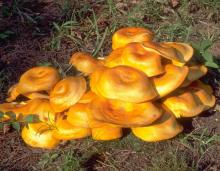
Species Types
Scientific Name
Omphalotus illudens (formerly O. olearius)
Description
Jack-o’-lanterns are bright orange to yellowish orange, with sharp-edged gills that descend the stalk. They grow in clusters, at the base of stumps, and from buried roots of oak and other deciduous wood.
Media
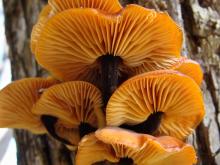
Species Types
Scientific Name
Flammulina velutipes
Description
The velvet foot, or enoki, has a tawny, sticky cap with whitish gills. The stalk is yellowish above and brownish below. They grow in clusters on deciduous logs.
Media

Species Types
Scientific Name
Grifola frondosa
Description
Looking like a ruffled chicken, the edible hen of the woods mushroom grows like large circular bouquet of spoon-shaped caps, each grayish brown on top and white beneath, emerging from a branching, whitish base. It grows on the ground at the base of oak trees.
Media

Species Types
Scientific Name
Meripilus sumstinei (formerly M. giganteus)
Description
The black-staining polypore grows in large, circular clusters of many fleshy, grayish yellow, fan-shaped caps, which bruise black when cut or touched. It grows on the ground around deciduous trees, especially oaks.
Media
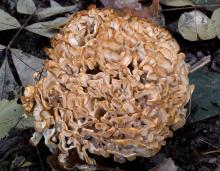
Species Types
Scientific Name
Sparassis spathulata (S. herbstii)
Description
The eastern cauliflower mushroom is a large, stalkless, whitish yellow rosette with flattened, wavy, ribbonlike folds. It grows singly, at the bases of trees and often at the base of decayed oak stumps.
Media

Species Types
Scientific Name
Cantharellus lateritius
Description
The smooth chanterelle has a bright orange to yellow cap, wavy margins, and is smooth on the underside. It grows singly or in large groups in the soil.
Media

Species Types
Scientific Name
Hydnum repandum (Dentinum repandum)
Description
The hedgehog mushroom has an irregularly shaped, dull orangish tan cap, with spines or "teeth" on its underside. It grows on the ground in mixed woods.
Media
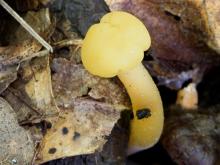
Species Types
Scientific Name
Leotia lubrica
Description
The jelly baby is a small mushroom with a gelatinous, orangish yellow stalk and head. It grows in groups on soil in mixed woods.
Media
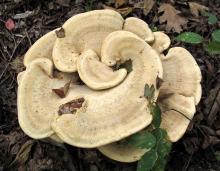
Species Types
Scientific Name
Bondarzewia berkeleyi
Description
Berkeley’s polypore grows in rosettes or clusters of fleshy, cream-colored caps, with whitish pores that descend the stalk. Look for them on the ground near the bases of trees.
See Also



Media

Species Types
Scientific Name
Monotropa hypopitys
Description
Pinesap is a plant that puts the "wild" in wildflower! It lacks chlorophyll, so its roots connect to fungi underground and absorb nutrients from the fungi.
Media

Species Types
Scientific Name
Cladophora, Pithophora, and Spirogyra spp., and others
Description
Filamentous green algae forms green, cottony masses that are free-floating or attached to rocks, debris, or other plants.
Media

Species Types
Scientific Name
Monotropa uniflora
Description
Indian pipe lacks chlorophyll, so it is white, not green. Below ground, its roots join with fungi that connect to tree roots. This plant, then, takes nourishment indirectly from the trees.
About Mushrooms in Missouri
Mushrooms are a lot like plants, but they lack chlorophyll and have to take nutrients from other materials. Mushrooms are neither plants nor animals. They are in a different kingdom — the fungi. Fungi include the familiar mushroom-forming species, plus the yeasts, molds, smuts, and rusts.
Always be cautious when eating edible mushrooms. Be absolutely sure of the ID, and only eat a small amount the first time you try it to avoid a reaction..





















